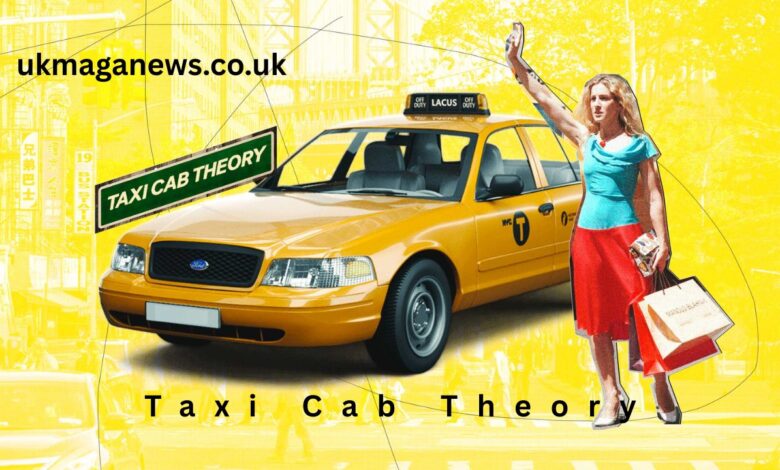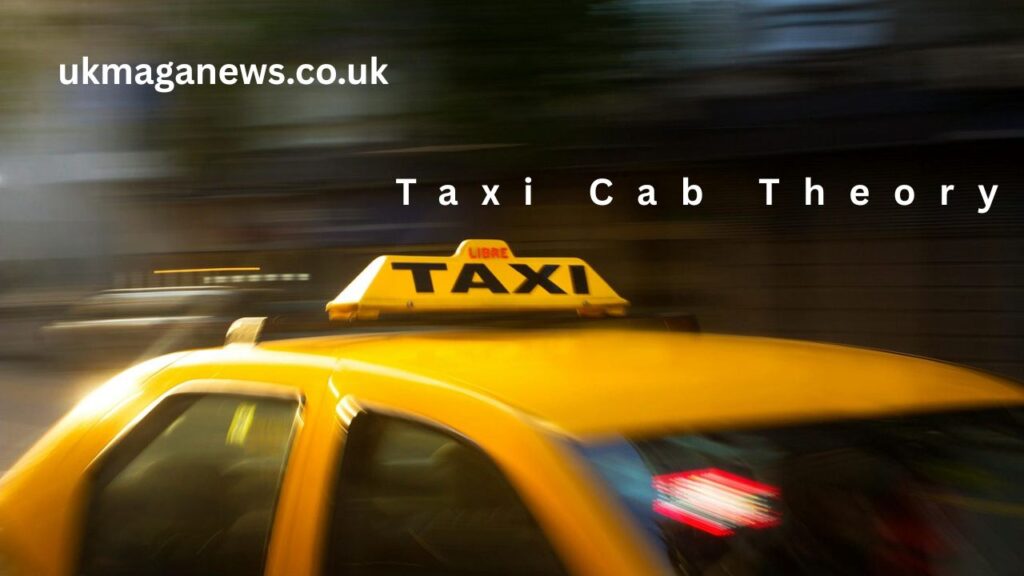Understanding the Taxi Cab Theory: Insights and Applications

Introduction to Taxi Cab Theory
The taxi cab theory, a concept that emerged prominently from urban economics, serves as a fundamental framework for understanding various human behaviors and social interactions in urban environments. Originating in the late 20th century, this theory illustrates the relationship between distance, cost, and decision-making, specifically in the context of transportation and urban planning. The primary premise of the taxi cab theory is that individuals make choices based on their immediate environment, weighing the perceived costs against the benefits they derive from their actions.
In psychology, the taxi cab theory finds relevance in understanding how people respond to stimuli in urban settings. It posits that the proximity of resources—such as jobs, recreational areas, and essential services—significantly impacts individuals’ day-to-day decision-making processes. For example, when a person considers commuting to work, their choice of transportation (e.g., using a personal vehicle or a taxi cab) hinges on factors like distance, cost, and convenience.
Furthermore, the theory extends its applicability to urban planning and economics, where it highlights the significance of geographic considerations in the allocation of resources and the design of infrastructure. City planners often apply the taxi cab theory to develop efficient transportation systems, ensuring that daily commuters experience minimal costs while maximizing accessibility to essential services. In economics, it aids analysts in evaluating market behaviors, particularly how businesses choose locations based on customer demographics and proximity.
Overall, the taxi cab theory provides a crucial lens through which various disciplines can explore the intricate relationship between human behavior, economic decision-making, and urban design. Understanding this theory not only contributes to academic discourse but also informs practical applications that can lead to more efficient urban spaces.
Historical Background
The taxi cab theory, a concept utilized in various academic fields including sociology and psychology, has its origins rooted in the early explorations of choice theory and decision-making processes. This theory gained particular prominence in the late 20th century when researchers began to investigate how individuals prioritize options in situations laden with uncertainty. The metaphor of a “taxi cab” serves as an accessible analogy for understanding the navigation of choices, paralleling the decision-making process a passenger undergoes when selecting a destination.
One of the key figures associated with the development of the taxi cab theory is economist Daniel Kahneman, whose work on behavioral economics has significantly influenced how we interpret human decision-making behaviors. Kahneman, alongside his colleague Amos Tversky, challenged traditional economic models, positing that people do not always act rationally when faced with uncertainty. Their research laid a foundation for understanding how individuals might select a ‘taxi cab’ based not only on cost and time but also on psychological factors such as perceived safety and convenience.
Additionally, the taxi cab theory also draws from experiments conducted in the realm of social psychology. For example, studies exploring the concept of cognitive biases have illuminated how individuals make choices in complex scenarios, akin to selecting a taxi cab amid numerous options. These works emphasize that choices are not just economic calculations, but are also influenced by social contexts and individual perceptions.
Through an examination of these foundational studies and key figures, it becomes evident that the taxi cab theory encapsulates a blending of theoretical perspectives. This theory continues to evolve as it finds applications across various disciplines, enhancing our understanding of human decision-making in ever-complicated environments.
Key Principles of Taxi Cab Theory
The taxi cab theory serves as a metaphor to explain complex systems grouped under various fields such as economics, logistics, and social sciences. At its core, the taxi cab theory illustrates how different variables interact to produce specific outcomes in the transportation sector. One pivotal principle is the concept of demand and supply. Just as the demand for taxi services fluctuates based on passenger needs, various factors like the time of day, traffic conditions, and economic environment influence these interactions in broader applications.
Another essential principle of the taxi cab theory is the notion of optimization. In the context of taxi services, optimization refers to the efficient allocation of resources—namely, drivers, vehicles, and routes. This optimization can be mirrored in other areas, including business operations and urban planning, where maximizing resource utilization is critical to improving performance and reducing costs. Technological advancements in route mapping and the integration of real-time data exemplify how the theory adapts to modern advancements, thereby enhancing efficiency and service delivery.
Furthermore, the theory touches on behavioral economics by understanding how human decision-making affects outcomes. For instance, the choices a passenger makes in selecting a taxi can be influenced by various psychological factors, including perceived trustworthiness, price, and availability. This component underscores the importance of human behavior in transportation and the implications for service providers who must cater to these tendencies to optimize their offerings.
The interplay between these principles of demand and supply, optimization, and human behavior captures the essence of the taxi cab theory, providing a robust framework for understanding the dynamics of various systems. As these components meld together, they enrich our comprehension of how similar concepts apply across different domains, revealing the universal applicability of the taxi cab metaphor.
Applications in Urban Planning
The taxi cab theory provides a valuable framework for understanding urban transportation dynamics and informs various aspects of urban planning. It emphasizes the importance of spatial distribution and accessibility in efficient transportation systems. By analyzing how people move within city environments, planners can optimize routes, reduce travel times, and enhance the overall efficiency of the urban transport network.
One notable application of the taxi cab theory can be observed in the development of integrated transportation strategies in metropolitan areas. Cities like New York and London have utilized this theory to improve their public transit systems. For instance, geographical data on taxi cab usage often reveals high-demand corridors and peak travel times, which then guide the expansion and frequency adjustments of bus and subway services. Moreover, such analyses help in determining strategic locations for new taxi stands or rideshare pick-up points, enhancing commuter convenience and reducing wait times.
Additionally, the taxi cab theory has been employed in the realm of smart city initiatives, where data analytics plays a crucial role. By analyzing how cabs navigate urban landscapes, city officials can identify traffic congestion hotspots and implement targeted traffic management measures. This may include altering traffic signal timings, creating dedicated lanes for taxis, or enhancing signage to guide drivers effectively. The use of real-time data from taxi services not only informs better urban design but also promotes sustainable transportation solutions, encouraging more residents to utilize shared cab services instead of personal vehicles.
Overall, the taxi cab theory serves as an instrumental tool in urban planning, guiding decision-making and policy formulation. Its applications are critical for developing a more efficient, accessible, and sustainable urban transport ecosystem that meets the evolving needs of city populations.

Impact on Behavioral Economics
The taxi cab theory has significant implications within the realm of behavioral economics, primarily by providing a framework through which consumer behavior can be understood and analyzed. This theory suggests that human decision-making processes are often influenced by the immediate gratification of benefits and the perceived costs involved, similar to how a passenger in a taxi chooses their route based on current traffic conditions and fare estimates. This perspective enables economists and marketers to decipher why consumers may opt for suboptimal choices under certain conditions.
One of the critical aspects of the taxi cab theory is its emphasis on the context within which decisions are made. Behavioral economics posits that individuals often deviate from rational decision-making due to biases and contextual factors. For instance, a consumer might choose a product based on its placement in a store or the influence of social proof, which can be likened to a passenger influenced by the most visible route in a taxi. Such insights can help businesses tailor their marketing strategies, ensuring that they are aware of how different variables can impact consumer choices.
Moreover, the theory highlights the importance of framing and perception in decision-making processes. In the context of behavioral economics, how options are presented can significantly alter consumer responses and preferences. For example, a taxi driver might choose a longer route if they believe it will result in a higher fare, paralleling how consumers can be swayed by perceived value rather than actual price. By bridging theory with practical applications, business strategists can enhance their understanding of market dynamics and improve their approaches to consumer engagement.
Overall, the taxi cab theory serves as a valuable tool for exploring the behavioral intricacies of economic decisions, fostering a deeper comprehension of how consumers navigate the choices available to them in a complex marketplace.
Taxicab Theory in Psychology
The taxi cab theory, while originating from transportation and urban studies, has found its way into psychological discourse as a metaphor for understanding human behavior and interactions in various contexts. At its core, this theory can illustrate how individuals navigate their social environments, analogous to how a passenger navigates a city using a taxi cab. Just as a passenger’s experience can be influenced by the choice of route and destination, human behavior is shaped by the decisions made in social contexts and the environmental factors at play.
One salient aspect of the taxi cab theory in psychology revolves around decision-making processes. Individuals often face choices that resemble the decision of selecting a cab; these choices can range from trivial to life-changing. The environment plays a pivotal role in shaping these decisions. For example, factors such as cultural norms, peer pressure, and situational cues can all act as ‘traffic signals’ that guide individuals toward specific choices. This metaphor highlights how external influences significantly affect personal decision-making, emphasizing the importance of context in psychological evaluations.
Moreover, the taxi cab theory also sheds light on social interactions. Just as a taxi cab fosters connections between the passenger and the driver, social interactions are pathways through which relationships are formed and maintained. In psychological terms, these interactions can help illustrate concepts such as social support, belongingness, and attachment. By understanding the taxi cab theory, psychologists can better grasp the dynamics of interpersonal relationships and the varying factors that contribute to an individual’s social experience.
In summary, the integration of taxi cab theory within psychology offers invaluable insights into human behavior, decision-making, and the nuances of social interactions. By acknowledging and analyzing the environmental influences—much like the routes taken by a taxi—the discipline can enrich its understanding of the complexities involved in human psychology.
Critiques and Limitations
The taxi cab theory, while presenting an intriguing framework for understanding decision-making processes, is not without its critiques and limitations. Scholars have raised concerns regarding the theory’s applicability across various contexts. One of the primary arguments against the taxi cab theory is its oversimplification of complex human behavior. Critics argue that human decision-making is influenced by a multitude of factors beyond mere directional prompts, such as emotional states, social dynamics, and individual cognitive biases. Consequently, relying solely on the taxi cab theory may lead to incomplete or inaccurate representations of decision-making phenomena.
Furthermore, another significant limitation is the theory’s premise that choices are predominantly binary—either to get into the taxi or not. This binary approach can overlook the multifaceted nature of situations where individuals may be faced with several alternatives or competing influences, thus complicating the decision-making landscape significantly. Critics posit that the linearity of the taxi cab theory may not accurately reflect real-world complexities, where decisions often involve trade-offs and compromises among various competing factors.
Another aspect worth noting is the lack of empirical support for some of the assumptions underpinning the taxi cab theory. While it may hold in specific scenarios, the lack of extensive qualitative or quantitative backing raises concerns regarding its generalizability. Scholars point out that without robust empirical evidence to validate the claims made by the taxi cab theory, its practical applications remain questionable, especially in diverse fields such as psychology, economics, and sociology.
In light of these critiques, it is essential for researchers and practitioners to approach the taxi cab theory with a critical mindset, weighing its insights against its limitations to ensure a more nuanced understanding of decision-making processes.
Future Directions for Research
The taxi cab theory serves as an insightful framework for understanding various aspects of urban dynamics, particularly in relation to transportation systems and their impact on social interactions. As we look to the future, several directions for further research emerge, taking into account technological advancements, urbanization trends, and evolving societal patterns. These areas are vital for enhancing the relevance and application of the taxi cab theory.
First, the rise of autonomous vehicles and ridesharing services presents an opportunity to evaluate how these innovations might reshape our understanding of the taxi cab theory. Researchers can explore how the proliferation of ride-hailing apps alters patterns of urban mobility and influences social behaviors, particularly in densely populated cities. Additionally, examining how these changes affect urban planning and infrastructure will contribute to a deeper understanding of the dynamics at play.
Moreover, the increasing trend of urbanization warrants robust research into how densely populated areas adapt and evolve. The implications of rising population densities on transportation networks and public spaces could significantly influence the taxi cab theory. Investigating the interplay between urban growth and its effects on service availability, accessibility, and social interactions may uncover nuanced insights that are relevant to urban sociologists and city planners alike.
Lastly, shifting societal patterns, such as changes in demographics and lifestyles, necessitate thorough research to understand their impact on the taxi cab theory. As societal norms evolve, including preferences for commuting options and environmental considerations, researchers must assess how these factors reconfigure existing transportation frameworks. Such investigations will not only enhance theoretical discourse but will also guide practical implementations, ensuring that urban transport systems are holistic and responsive to the needs of an ever-changing society.
In conclusion, the future of research on the taxi cab theory is promising, with significant opportunities to derive lessons from contemporary technological advancements, urban growth, and changing social dynamics. By pursuing these avenues, scholars can enhance the understanding of how these elements interconnect, thereby reinforcing the relevance of the taxi cab theory in modern urban studies.
Conclusion
The taxi cab theory presents a fascinating lens through which to examine various societal dynamics and interactions. Throughout this article, we have explored the foundational principles of the theory, highlighting its practical implications in diverse fields such as urban planning, transportation economics, and social behavior. The essence of the taxi cab theory underscores how simple decision-making processes can help illuminate complex societal patterns and human interactions.
One of the key points discussed is the analogy of the taxi cab as a representation of choice and accessibility in metropolitan environments. By evaluating how individuals opt for transportation modes, we gain insights into broader issues such as urban development, traffic management, and resource allocation. The theory prompts us to consider how the availability and efficiency of taxi services influence not only individual mobility but also overall city functionality. In this sense, the taxi cab theory serves as a vital framework for understanding urban design and community needs.
Moreover, the implications of the taxi cab theory extend beyond mere transportation considerations. It encourages a deeper examination of social equity and accessibility, particularly in underserved communities. Recognizing the barriers that certain populations face in accessing reliable transit can drive policy changes aimed at enhancing equity and improving quality of life. Thus, the taxi cab theory is more than just an analytical tool; it is a call to action for both scholars and practitioners to prioritze inclusivity in transport systems.
In conclusion, the taxi cab theory sheds light on essential connections between individual behavior, societal infrastructure, and urban policy decisions. Emphasizing its relevance can foster a greater understanding of how these elements interplay, leading to more informed decision-making and improved outcomes in urban environments.
Also Read ukmaganews.co.uk


